Text
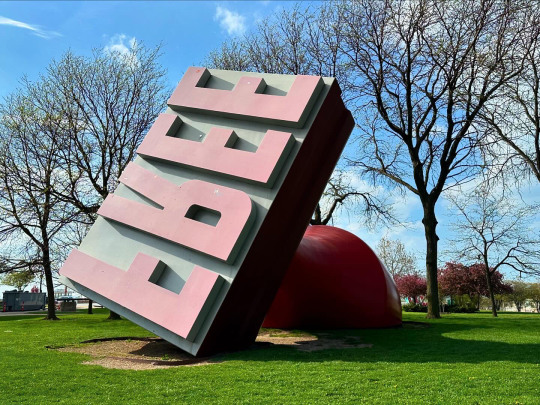

Claes Oldenburg and Coosje van Bruggen created Free Stamp, the 70,000 pound sculpture, pictured above, in 1985.
Cleveland Historical, which has detailed numerous historical sites in the city, provides a detailed history of the sculpture. They also have an app to simplify exploring the city.
Below is a section from their website about Free Stamp–
…Commissioned by the Amoco Company in 1982, the Stamp was designed and fabricated in 1985. At the time, Amoco owned Sohio (Standard Oil of Ohio) and the building now known as 200 Public Square, and the piece was intended to reside in front of the building. But in 1986, before installation could happen, Amoco, Sohio and the building were acquired by BP America. The new owners refused to mount the sculpture—perhaps believing that “Free Stamp” was a metaphoric aspersion. Art historian Edward J. Olszewski has also noted that, in England, Pop Art is viewed more cynically and politically than in the United States, where it is considered primarily whimsical. Oldenburg is on record as saying that “free,” references the emancipation of American slaves during and after the Civil War—a plausible explanation given the piece’s planned proximity to the Soldiers’ and Sailors’ Monument.
So instead of adorning Public Square, the Free Stamp was denied its freedom: imprisoned instead in a warehouse in Illinois. There it gathered dust for five years before then-mayor George Voinovich invited Oldenburg and van Bruggen to Cleveland in hopes of selecting another site.
It eventually was decided that the Stamp should be located in Willard Park on Lakeside Avenue just west of East 9th Street; and BP agreed to gift it to the city of Cleveland with all installation and maintenance expenses covered. However, disagreements arose about how the sculpture would be positioned. The original intent was for the Stamp to stand face down on Public Square. However, Cleveland city planners felt that this approach was not right for Willard Park and the Stamp ultimately was mounted angularly, with the faux-rubber “FREE” proudly visible. According to Oldenburg, it was as if “a giant hand picked up the Free Stamp and angrily hurled it several blocks to its current location at Willard Park.” Not surprisingly, the Stamp—formally dedicated on November 15, 1991—aims directly at 200 Public Square “It’s pointed on a diagonal to the 23rd floor, which were [BP’s] corporate offices,” notes Olszewski. “It leads the viewer back to the original site.”
#Claes Oldenburg#Coosje van Bruggen#Art#Cleveland Historical#Cleveland Public Art#Free Stamp#Ohio Public Art#Public Art#Sculpture#Art Installation
0 notes
Text
youtube
Erick the Architect- “2-3 Zone”
This song is from Erick the Architect’s 2024 album, I’ve Never Been Here Before.
He is playing at El Cid in Los Angeles on Wednesday, 5/1/24.
#Erick the Architect#Los Angeles Music Shows#Music#Music Monday#New Music#Playlist#Song of the Day#Spotify Playlist#Flatbush Zombies#Youtube
1 note
·
View note
Text
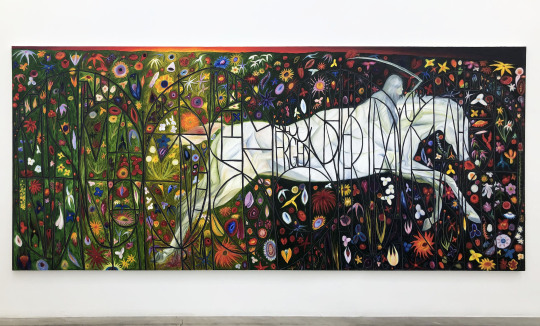
"Pale Rider", 2019, Oil on canvas
The large painting above is from Srijohn Chowdhury's 2019 exhibition, A Divine Dance, at Anat Ebgi in Los Angeles.
From the gallery-
Srijon Chowdhury’s paintings are characterized by moody symbolist compositions of richly colored floral and domestic settings. He conjures poetic and allegorical narratives through the use of myth, memory, and repetition.
Pale Rider, the largest painting in the exhibition, depicts an angelic woman with flowing hair riding horseback; its monumental scale envelopes viewers in a mystical narrative. The rider appears translucent and wields a scythe as she moves across a meadow of blooming flowers—an allusion to death and birth. In the foreground, there is a fence composed from a poem by William Blake titled “A Divine Image” that Chowdhury has turned into a sigil—an ancient practice of transforming pictorial text into a symbol that is considered to have magical powers. The poem speaks about destructive abstracts of human nature: cruelty, jealousy, terror, and secrecy.
Chowdhury’s work confronts universal physical and emotional themes. Soft aura of moonlight, glow of flowers, and dancing flames invite quiet contemplation. He sensitively vacillates between despair and hopelessness at the human condition, while brightening at joy, beauty, and hope that like flowers, life will go on.
#Srijohn Chowdhury#A Divine Image#Anat Ebgi#Art#Art Shows#Death#FBF#Los Angeles Art Shows#Painting#Pale Rider#Rebirth#Spring#Spring Painting#William Blake
0 notes
Text
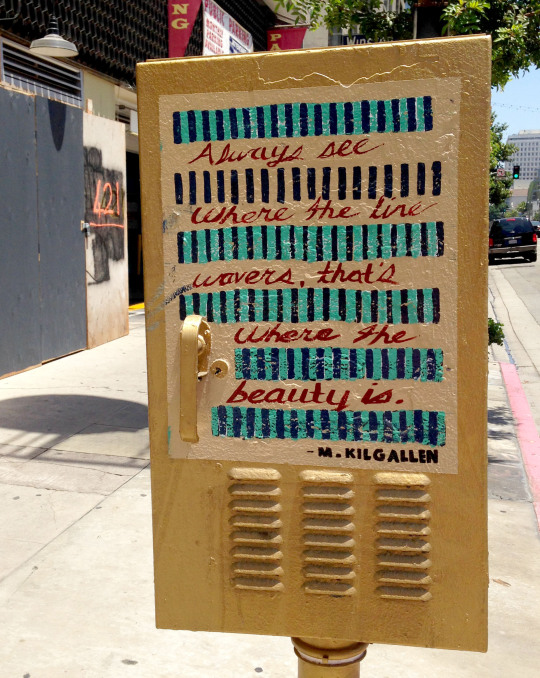
This tribute to artist Margaret Kilgallen was spotted in Los Angeles in 2014. The quote is paraphrasing what she said during an interview for the PBS program Art21. The full quote reads- “I do spend a lot of time trying to perfect my line work… when you get close up, you can always see the line waver. And I think that’s where the beauty is.” Kilgallen died of cancer in 2001, at only 33, but left behind a remarkable body of work.
You can currently see one of these works at Cantor Arts Center’s as part of the group exhibition, Day Jobs, on view until 7/21/24. The exhibition examines the impact of day jobs in the lives and work of several famous artists.
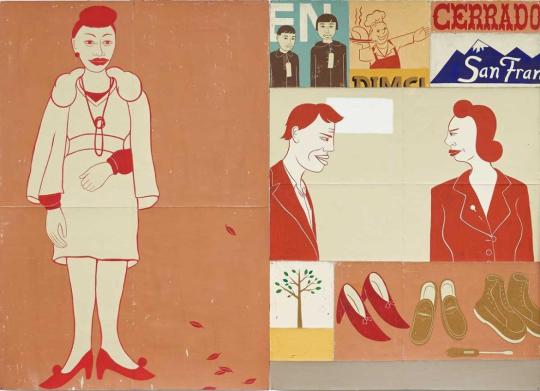
(Image courtesy of Cantor Arts Center: Margaret Kilgallen, “Money to Loan (Paintings for the San Francisco Bus Shelter Posters)” [detail], 2000. Mixed media on paper and fabric, sheet 68 × 48½ inches Courtesy of the Margaret Kilgallen Estate, photo by Tony Prikryl)
You can learn more about Kilgallen, her husband and fellow artist Barry McGee, and several other artists including Shepard Fairey, Mike Mills, Ed Templeton and Harmony Korine in Aaron Rose’s film Beautiful Losers.
youtube
#Margaret Kilgallen#Art#Art Documentary#Art Shows#Street Art Los Angeles#Art21#Cantor Arts Center#Artist Documentaries#Barry McGee#Beautiful Losers#California Art Shows#Collage#Day Jobs#Documentaries#Ed Templeton#Film#Aaron Rose#Harmony Korine#LA Street Art#Los Angeles Street Art#Mike Mills#Mixed Media Art#Painting#PBS Documentary#San Francisco Art Shows#Shepard Fairey#Stanford University#Street Art#Youtube
0 notes
Text

Alyssa Lizzini, “Industrial Valley”, Ink and acrylic on paper on panel
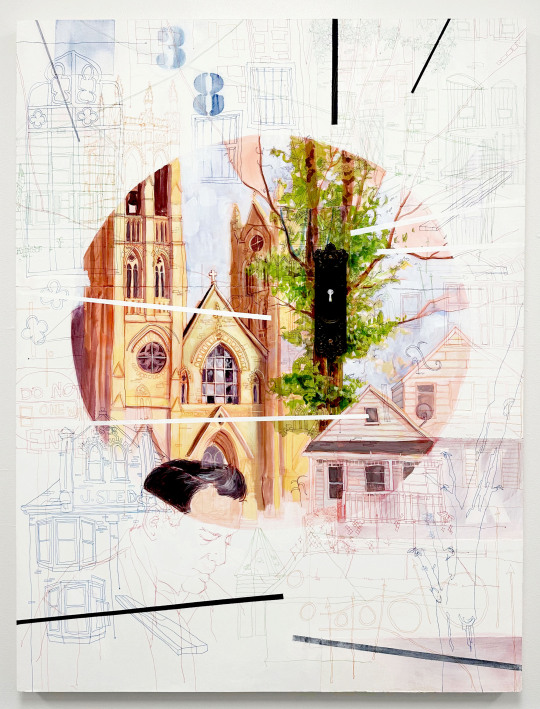
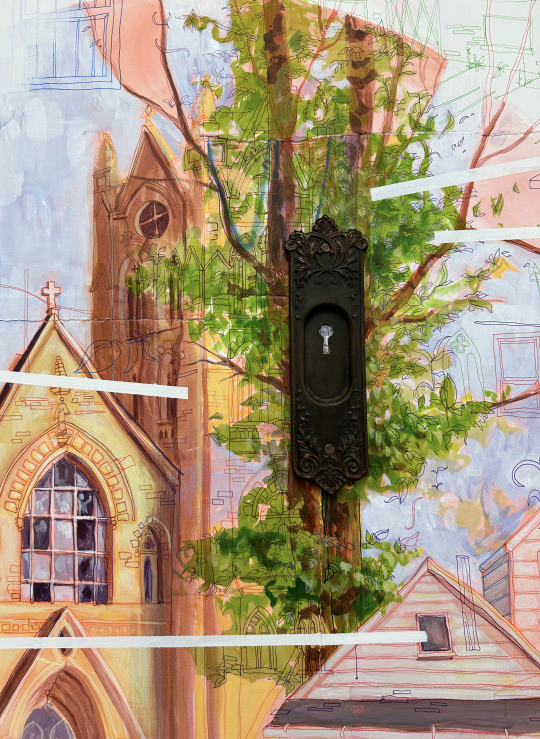
Alyssa Lizzini, “East 41st”, Ink, acrylic, and found object on paper and panel


Alyssa Lizzini, “Unraveling City”, Ink and acrylic on paper mounted on 2 panels
Akron Soul Train is currently showing two exhibitions by Ohio artists. Alyssa Lizzini’s The Universe Between Here and There, pictured above, expands upon scenes from daily life using a mixed media approach. The works take the viewer into her expanded sections of the city, and encourages them to think about what may be unobserved in their own daily life.
From the gallery-
In The Universe Between Here and There, Alyssa Lizzini explores the interwoven connection between space, time, and memory through large-scale, multi-layer drawings. Lines, grids, maps, and data become the stars, black holes, and supernovae of an ever-expanding universe of memory. Using ink, acrylic paint, and collaged paper, Lizzini creates overlapping images that seem to compress space and time yet simultaneously fly apart or implode. Her drawings suggest that memory unravels in much the same way and investigates the almost inseparable connection between person and place.
“Drawings explore both my own personal histories related to remembered places and broader histories recorded through archival, ethnographic, and visual research of city spaces…The scale of [my] drawings allow the viewer to feel immersed in each piece, surrounded by swirling and morphing cityscapes, memory objects, and natural elements. They ask the viewer to consider the many layers of context not immediately visible in our urban world, and give a new language for understanding the ever-changing nature of memory.” – Alyssa Lizzini
Akron Soul Train Artist-in-Residence Melih Meric’s uses traditional Middle Eastern patterns to explore identity.
From the gallery –
Meric uses a traditional approach to their imagery through sacred geometry and explorations of Islamic geometric abstraction. Challenging traditional presentations of print editions, Meric’s print work crosses the borders of the paper. It highlights an expansion of patterns like Middle Eastern tiles. It also speaks to queerness without being explicitly queer. Stitched Editions: Exploring the New poses integral questions surrounding erasure and identity in Middle Eastern communities. Meric’s craft lies in creating wall-hanging objects that play between the realms of dimensionality while still being unmistakably paper. Their work acknowledges and is proud of its dimension, speaking certain truths to multiple minority groups.
“My work deals with making peace with a part of my culture that drove me to leave it. Finding beauty in design and simplicity, then creating systems to complicate those principles. I fell in love with printmaking and the idea of multiplicity when I first made the connection to tiles from the Middle East. It suddenly became a tool to create and expand patterns that challenge traditions in crafts.” – Melih Meric
Both of these exhibitions close 5/11/24.
#Akron Art Shows#Akron Soul Train#Alyssa Lizzini#Melih Meric#Art#Art Shows#Collage#Mixed Media#Mixed Media Art#Mixed Media Painting#Ohio Art Shows#Ohio Artist#Ohio Artists#Printmaking#Woodblock#Woodblock Print
1 note
·
View note
Text

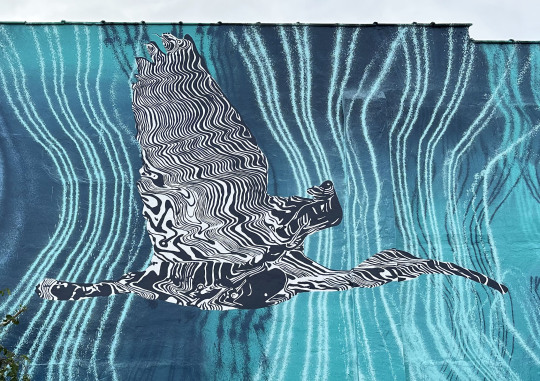
Rainbird, by Miami-based artist Douglas Hoekzema, aka Hoxxoh, was created for the 2023 edition of SHINE Mural Festival in St. Pete, Florida.
#Douglas Hoekzema#Hoxxoh#SHINE Mural Festival#Florida Murals#Florida Street Art#SHINE Mural Festival 2023#Mural#Murals#Shine On St. Pete#St. Pete Mural#St. Pete Murals#St. Pete Street Art#Street Art
4 notes
·
View notes
Text
youtube
A Beacon School- Mantra
This song is from A Beacon School’s 2023 album yoyo.
He is playing at Permanent Records Roadhouse in Los Angeles on Thursday 4/25 and Friday 4/26/24.
#A Beacon School#Los Angeles Music Shows#Music#Music Monday#New Music#Playlist#Spotify Playlist#Youtube
1 note
·
View note
Text

Meryl Engler, “Lying in Red”, 2023, Woodcut
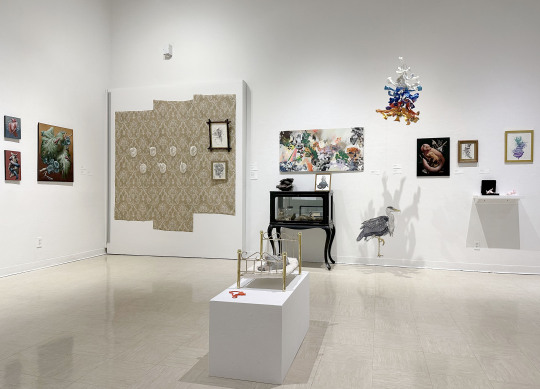

Work by Michael Loderstedt (left), Eva Pozler (center) and Lori Kella (right)
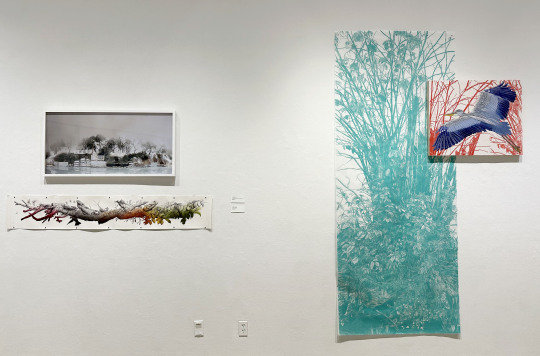
Work by Lori Kella, Maria Uhase, and Meryl Engler (right two pieces)

Lori Kella, “Mudslide and Forsythia”, 2022, Inkjet print (left) and Corrie Slawson, “Amalgam 4”, 2022 (top) and “Amalgam 3”, 2022 (bottom), Oil and screenprint on plywood
Today (4/19/24) is the last day to see Life Out of Balance at the Emily Davis Gallery at The University of Akron. The group show show includes work by Maria Uhase, Meryl Engler, Lori Kella, Benjamin Lambert, Michael Loderstedt, Eve Polzer, Ron Shelton, Ariel Bowman, and Corrie Slawson.
From the gallery-
When a tree falls in a forest, we may see it as the death of the tree. It stops photosynthesizing, growing, feeding its mycorrhizal symbionts, flowering, developing fruit, dispersing seeds, taking in carbon dioxide, and producing oxygen. But in the ecosystem, it begins a whole new life in decay. It feeds the soil and microbes through the decomposition of its tissues; it provides a place for fungi, mosses, and lichens to grow; and it becomes a protected habitat for a myriad of insects, mammals, and birds. This same tree, therefore, can be both dying and living at the same time, depending on perspective. It can be dead if considered separate from its surroundings, or it can be alive in its continued relationship within its ecosystem.
Humans can feel more alive by being integrated with the rest of the natural world. We are not living to our full potential, or allowing nature to be its full potential, when we consider ourselves as separate from it.
If we are to have hope for solving the complex environmental issues that are facing us today, we need to work with, rather than against, the forces of nature.
Below are a few more selections.

Ron Shelton, “Yellow Mosaic”, 2021, Plastic and wire
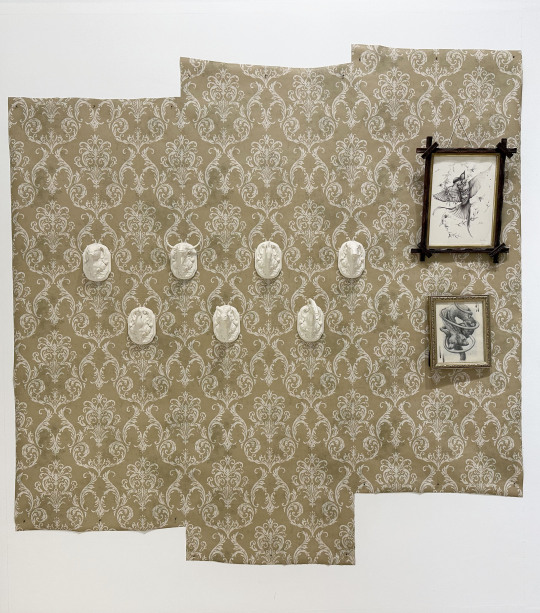
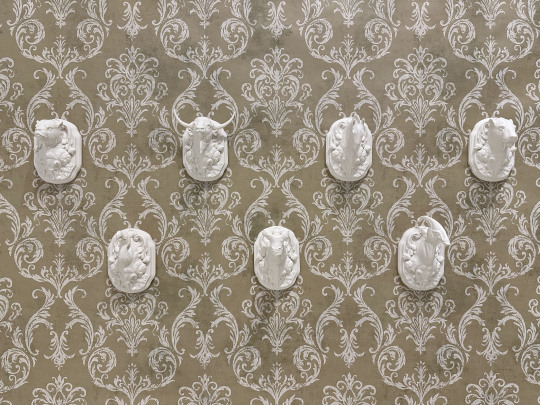
Ariel Bowman, “Wall Trophy Series”, 2019, (Cave Bear, Antique Bison, Early Horse, Saber Cat, Dodo, Brontotherium, Parasaurolophus), Unglazed, high fired porcelain; Maria Uhase, “Splitting Headache”, 2022 Ink on paper and “Softly”, 2023, Graphite on paper

Benjamin Lambert, “A pint for a gallon”, 2020 and “I Found Your Damn Lost Shaker of Salt”, 2020, Stoneware, underglaze, glaze, epoxy
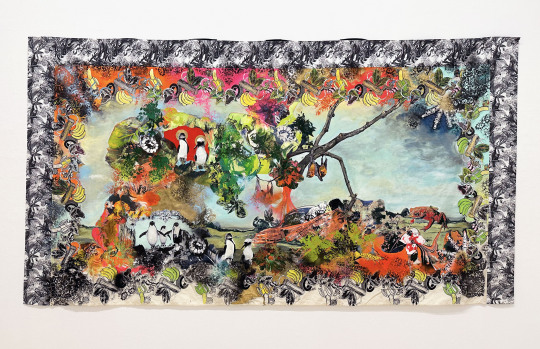

Corrie Slawson, “Stage Set Tapestry 1, for Feast: a ballet. Of Bats, Blue Footed Boobies, Penguins and other threatened fauna and flora. Pastoral landscape after Rubens”, 2020, Oil and mixed media on muslin
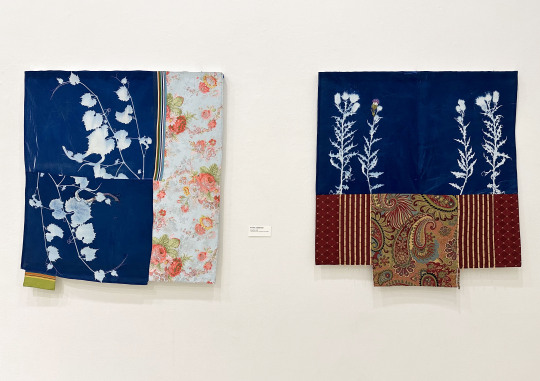
Michael Loderstedt, “Snakehead”, 2023, “Thistles”, 2023, Cyanotypes on fabric, embroidery, fabric collage

Lori Kella, “Mayflies in the Grass”, and “Yellow Irises”, 2024, Framed inkjet prints
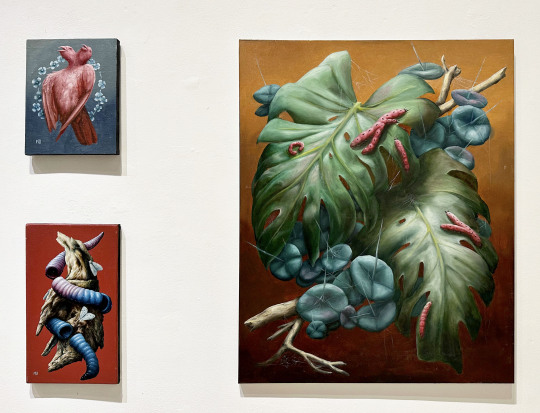
Maria Uhase, “Encircled”, 2023, Oil on linen panel, “Worm”,2023, Oil on linen and “Conglomeration in the Spiders’ Ghost Town”, 2020, Oil on canvas

Eva Polzer, “Gift from a Cat”, 2024, Ceramic, underglaze, velvet jewelry box, and “Gift from a Rat”, 2024, Ceramic, underglaze, petri dish

Meryl Engler, “Waiting”,2023, Woodcut Block
#The University of Akron#Emily Davis Gallery#Akron Art Shows#Ariel Bowman#Meryl Engler#Ron Shelton#Eve Polzer#Art#Michael Loderstedt#Maria Uhase#Art Shows#Lori Kella#Benjamin Lambert#Ceramic Art#Ceramics#Corrie Slawson#Cyanotype#Cyanotypes#Environmental Art#Environmental Photography#Fabric Art#Fabric Collage#Fiber Artist#Fiber Arts#Nature Photography#Ohio Artist#Ohio Artists#Painting#Photography#Printmaking
0 notes
Text
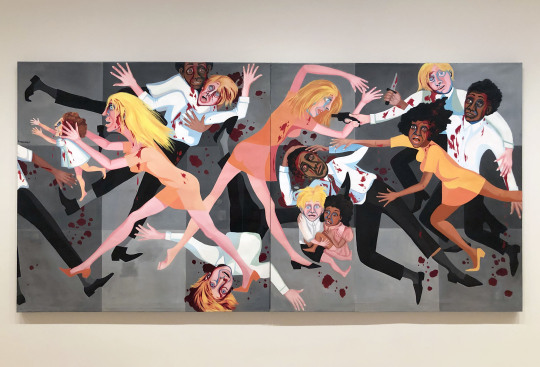
I was very sad to hear the news of artist and activist Faith Ringgold’s recent passing. Throughout her incredible career she created work in a variety of mediums including painting, sculpture, and narrative quilts. She also wrote and illustrated several children’s books- including the wonderful Tar Beach, based on one of the quilts, which won several awards.
Pictured above is American People Series #20: Die, 1967, currently on view at the Museum of Modern Art in New York.
From the museum about the work-
Recalling her motivation for making this work, Ringgold has explained, “I became fascinated with the ability of art to document the time, place, and cultural identity of the artist. How could l, as an African American woman artist, document what was happening around me?” Ringgold’s American People Series confronts race relations in the United States in the 1960s. This mural-sized painting evokes the civil uprisings erupting around the country at the time. On the canvas, blood spatters evenly across an interracial group of men, women, and children, suggesting that no one is free from this struggle.
#Faith Ringgold#Art#Artist#Children's Books#MOMA#Museum of Modern Art#Narrative Quilts#NYC Art#Painting#Quilt#Quilts#RIP#Tar Beach
1 note
·
View note
Text
youtube
Orbital- The Box
This song is from Orbital’s 1996 album, In Sides. They are currently on tour and playing Coachella on Saturday, 4/20/24.
The stop-motion video above, starring Tilda Swinton, was directed by Jes Benstock and Luke Losey. Benstock did an interview with 909originals for the 25th anniversary of its release in 2021.
#Orbital#Coachella#Coachella 2024#Electronic Music#Jes Benstock#Luke Losey#Music#909originals#Playlist#TBT#Tilda Swinton#stop motion animation
0 notes
Text
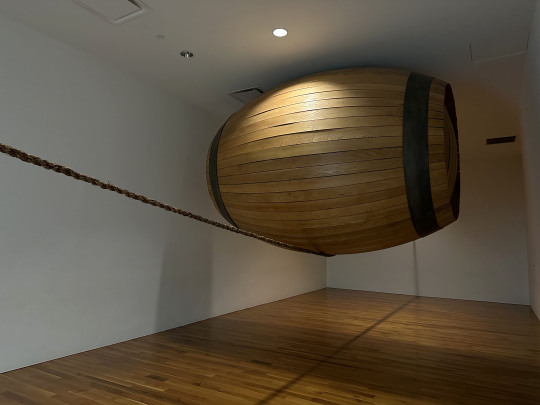

There’s an unsettling tension in the room that houses Mel Chin’s installation Spirit (1994), at the Columbus Museum of Art. Is the rope strong enough to support the barrel? What will be its breaking point?
Some details from the museum about the work-
The rope that seems to carry the weight of Spirit’s enormous cask is made from tallgrass. This native plant was once central to a vast prairie ecosystem spanning over 170 million acres of North America. By 1930, most all of this was decimated as a result of agricultural and industrial settlement, and what remains is protected habitat (Chin received special permission to harvest a portion for this sculpture).
Wooden barrels are traditionally used to measure and transport dry goods like grain, beans, as well as beer, oil and wine, and were central to the process of European settlement and trade in North America. Here, the image of this rope bearing such a massive weight suggests the precarious status of nature in a world of outsized human development. Even the gallery walls, which curve inwards on all sides, seem to respond to the strain.
#Mel Chin#Columbus Museum of Art#Art#Art Installation#Barrel#Columbus Art Shows#Environmental Art#Ohio Art Shows#Sculpture#Tension
1 note
·
View note
Text

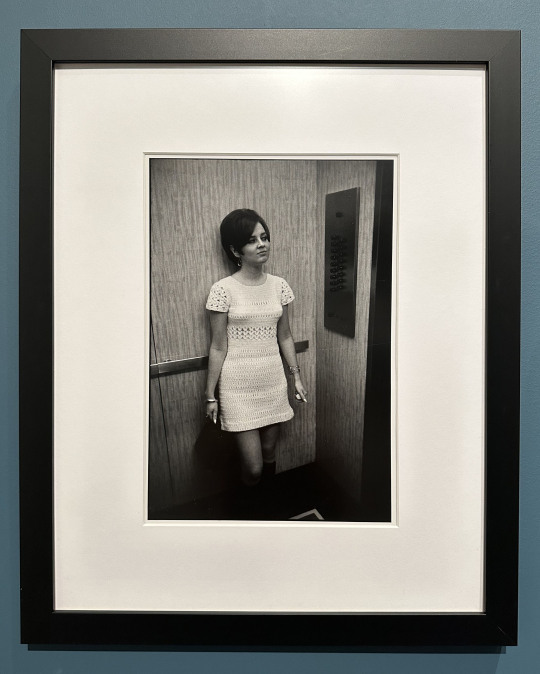

Currently Tampa Museum of Art is showing work from Garry Winogrand’s book, Beautiful Women. The photographs are from the 1960s and 1970s and are a fascinating glimpse of this time period. His ability to find and capture these brief moments is impressive. At the same time, some of the photos of these women feel invasive and, as said in the museum’s statement on the work below, voyeuristic.
From the museum-
Garry Winogrand was a master at photographing the unseen, extraordinary moments of everyday life. With his Leica camera, Winogrand photographed both up close and at a distance, but spontaneously as the image came together. He liked to break the rules of photography by ignoring traditional horizon lines and shooting at titled angles to create compositional allure.
Described as one of the 20th-century’s most influential street photographers, Winogrand often defied social decorum by getting into the space of his subjects – sometimes unknowingly to the person and at other times to their great annoyance. He captured life in the 1960s and 1970s in the blink of an eye, preferably with his 28mm lens which allowed more of what was in front of him to be featured in the frame. Winogrand once remarked, “I photograph to see what the world looks like in photographs.”
Women are Beautiful represents of one Winogrand’s most celebrated yet controversial artworks. His magnum opus, Women are Beautiful was first published as a book in 1975 and later printed as a portfolio in 1981. Comprised of 85 photographs, the works were shot over a ten-year period between 1965 and 1975, notably at the height of second-wave feminism and the sexual revolution, the anti-war movement, and the civil rights movement. As the title suggests, women served as the inspiration for the project. Winogrand culled images from his extensive archive that emphasized the confidence, vibrancy, and individuality of the American woman. While the photographs have been lauded as artifacts of their time, the works have also been criticized as voyeuristic and invasive to women’s privacy. Both observations deserve consideration in viewing this body of work.
The presentation of Women are Beautiful in this gallery follows the format of the book, which is now out of print. Winogrand selected the images and organized the photos without reference to subject, date, and place. Apart from the first photograph in the series, the images are presented as pairs to represent Winogrand’s book spreads. This arrangement aims to highlight how the photographer viewed and read his pictures. While women anchor the photographs, Winogrand looked at the total image-such as the other people in the photo or the quietness of solitude, the surrounding landscape, and the objects featured in the frame. At quick glance, the connections between images may not appear readily visible but it is in these photographs that Winogrand invites viewers to take a longer, closer look at the pictures. Subtle gestures such as the common angle of limbs and facial profiles, or shadows, corners, and lines – even the shared shading of a hat and tree-inspired Winogrand’s paired selections. Viewed together, the photographs reveal a deliberate sequencing and pacing, like a storyboard or film. Winogrand’s Women are Beautiful offers insight into the vantage point of one the 20th-century’s most accomplished photographers.
Below are some of the pairs from the show.


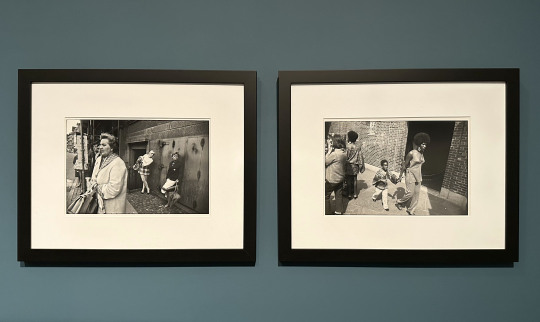
This exhibition closes 4/21/24.
#Garry Winogrand#Tampa Museum of Art#Art#Art Book#Art Shows#Beautiful Women#Black and White Photography#Florida Art Shows#Photography#Photography Books#Tampa Art Shows
0 notes
Text
youtube
feeble little horse- Tin Man
This song is from feeble little horse’s 2023 album, Girl with Fish.
The band is opening for bar italia at Fonda Theatre in Los Angeles on Thursday, 4/18/24. They are also playing Coachella this Sunday.
#feeble little horse#Los Angeles Music Shows#Music#Music Monday#Music Shows#Playlist#Song of the Day#bar italia#Youtube
1 note
·
View note
Text
I’ve recently decided to add a weekly newsletter using Substack. It’s a place to put some of the ideas and discoveries that don’t make it here. It also recaps the week’s blog posts.
Check it out and subscribe!
0 notes
Text
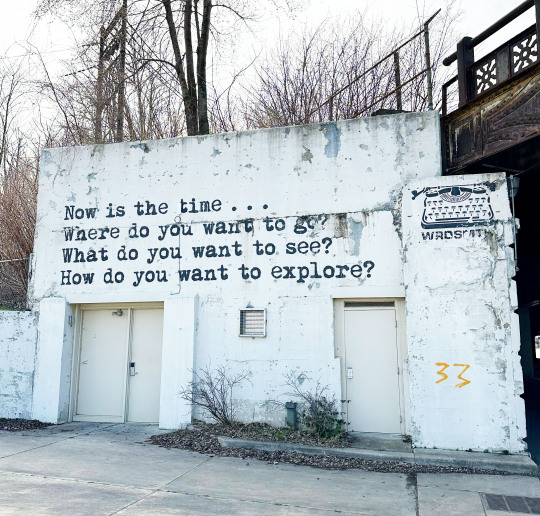
This mural by Los Angeles based writer and artist WRDSMTH is located near The Sculpture Center in Cleveland.
You can find his most recent work on Instagram.
#Wrdsmth#Cleveland Mural#Cleveland Murals#Cleveland Street Art#Exploration#Murals#Now is the Time#Ohio Murals#Ohio Street Art#Street Art#The Sculpture Center#The Sculpture Center Cleveland
0 notes
Text

“Erika”, 2021, VCT, shotgun shells, and drink stirrers

“Duke the Fisherman’s High Quality Fluke Rigs Made in the USA™”, 2022, Found tampon applicators, fishing line, fishing hooks, nail polish, peg board, card stock

Detail of “Monument to Five Thousand Years of Temptation and Deception V, VI, VII”, 2022, Salvaged plastic, paint, fishhooks
The images above are from Duke Riley’s exhibition DEATH TO THE LIVING, Long Live Trash, on view at Brooklyn Museum in 2023. The artist’s inventive fishing lures, made from discarded plastic items found around waterways, are engaging to look at but highlight the grim reality of how much garbage is polluting our natural environment.
From the museum-
In DEATH TO THE LIVING, Long Live Trash, Brooklyn-based artist Duke Riley uses materials collected from beaches in the northeastern United States to tell a tale of both local pollution and global marine devastation. Riley’s contemporary interpretations of historical maritime crafts—such as scrimshaw, sailor’s valentines, and fishing lures—confront the catastrophic effect that the oil, food, and beverage industries have had on the environment through single-use plastics. The works are presented in the seventeenth- and eighteenth-century Jan Martense Schenck and Nicholas Schenck Houses, alongside a selection of historical scrimshaw from our collection, directly connecting environmental injustices past and present.
In his contemporary interpretations of scrimshaw—ink drawings etched into bone by sailors—Riley replaces the medium’s customary whale teeth with repurposed plastic containers, detergent bottles, toothbrushes, and other waste. The works incorporate the maritime imagery traditional to scrimshaw, but expand it to portray international business executives that the artist identifies as responsible for the perpetuation of single-use plastics. Also on view are Riley’s fishing lures and sailor’s valentines, similarly created with detritus found on northeast coastal beaches. The exhibition juxtaposes corporation-driven pollution with new short films by Riley that highlight New York community members working to remediate plastic damage and restore our waterways.
Erika, the mosaic pictured above, depicts the 1999 shipwreck of MV Erika which, after splitting in two during a heavy storm, released thousands of tons of oil into the Bay of Biscay off the coast of Brittany.
In the video below, Riley gives a brief tour of the Brooklyn show.
youtube
Some of the work from this exhibition is currently on view at Museum of Fine Arts St. Petersburg as part of their exhibition, The Nature of Art.
#Duke Riley#Brooklyn Museum#Environmental Art#Recycled Plastic#Fishing Lures#Mixed Media Art#Museum of Fine Arts St. Petersburg#MV Erika#Art Installation#Recycled Art#Sculpture#The Nature of Art#Trash#Wallpaper#fbf#Youtube
0 notes
Text
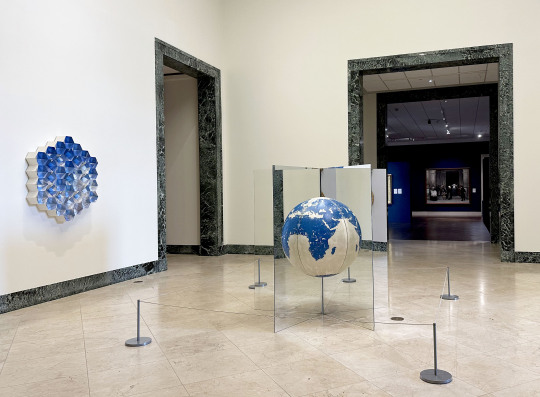
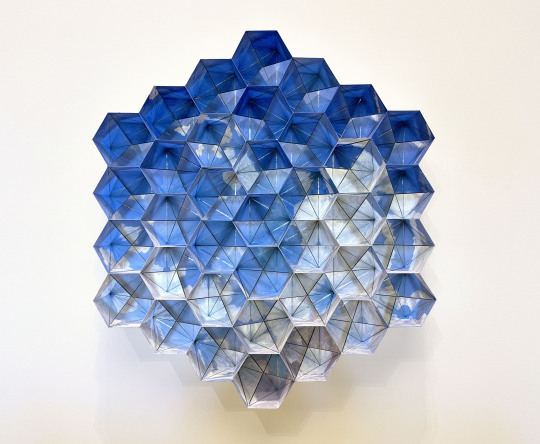
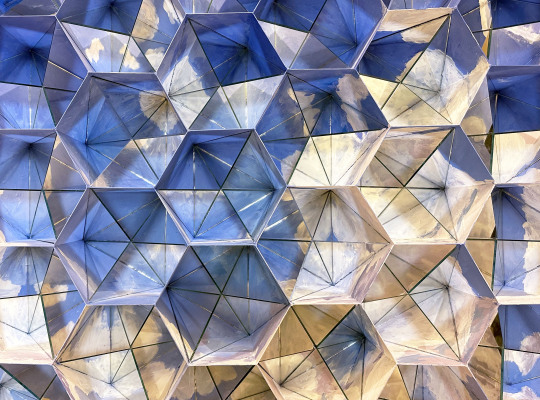
Brookhart Jonquil, “Groundless”, 2023, Mirrors, steel, acrylic paint, enamel paint
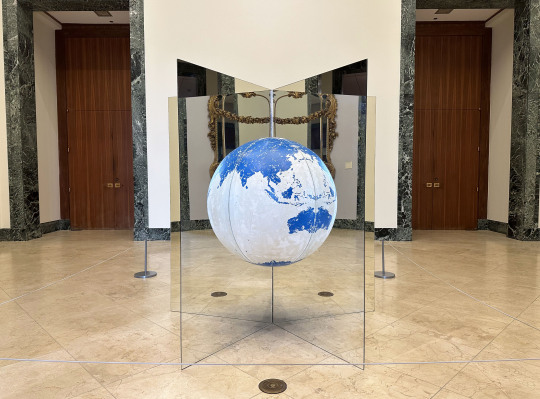
Brookhart Jonquil, “E)A)R)T)H)”, 2012, Mirrors, EPS, MDF, plaster, paint

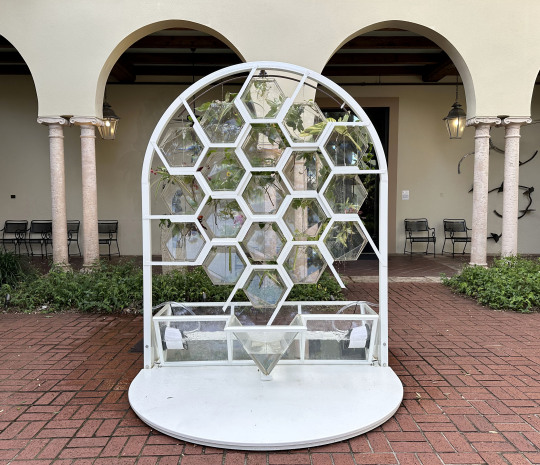


Brookhart Jonquil, “Multiplication Portal”, 2022, Plexiglass, water, powdercoated steel, plant cuttings, marine polymer sheet, pump system
For The Nature of Art at the Museum of Fine Arts St. Petersburg, work from the exhibition is spread throughout different sections of the museum. In the Great Hall and Sculpture Garden are installations by Brookhart Jonquil.
From the museum about these works-
In this group of installations, Brookhart Jonquil creates art that engages physics, architecture, and ecology to explore the immaterial, shifting aspects of the natural world. His work reflects influences ranging from Minimalism to theories of utopia and perfection; it offers viewers new ways of seeing and a nuanced understanding of our place in the world. The works exhibited here and in the Sculpture Garden encompass over a decade of his career, illustrating how nature has always influenced his artistic practice.
Groundless is Jonquil’s most recent work, inspired by painting en plein air, the Impressionist practice of working outdoors. However, the artist has complicated this by incorporating mirrored surfaces that deny full control of his compositions. Jonquil notes, “Each stroke of paint multiplies unpredictably as I place it, while shifting colors and cloud-forms evade fixity.”
The floor-based sculpture E)A)R)T)H) uses five pieces of mirror glass to dissect an earthly sphere. Unlike Groundless, these mirrors reflect the Great Hall, foyer, and surrounding galleries, suggesting a macro-and micro-viewing of our planet. To further a sense of dislocation, Jonquil has inverted the colors typically associated with land and water: bodies of water are depicted in white, while land is blue.
Multiplication Portal-on view in the Sculpture Garden- is a participatory sculpture highlighting the care and responsibility involved in cultivating plants. Reminiscent of both a kaleidoscope and a beehive, it was inspired by chaos theory-also known as the butterfly effect, which is the idea that one tiny gesture can have colossal consequences within dynamic systems. Brookhart created Multiplication to fight environmental disillusionment. Can one individual impact the impending climate disaster? What is the point of separating paper and plastic? Does turning off the lights make a difference? Multiplication Portal serves as a reminder that our seemingly small actions have the potential for significant consequences.
In an upstairs gallery is the video installation, Blood, Sea by Janaina Tschäpe (seen below). The dreamy video takes you underwater to explore transformation through sea maiden myths.
Information on the installation from the museum-
Reminiscent of Voltaire's Micromégas, Janaina Tschäpe's fantastical scenes dissolve boundaries, seamlessly intertwining in an ever-flowing continuum of evolution and transformation in a grand opera that delves into themes of change, gender, and the construction of myth and history. The universe created by Tschäpe beckons one into a parallel world of ambiguous scale-indeterminate in both time and space. The spring-fed grotto provides the scenographic impetus for this grand production, a captivating fusion of a theme park nestled within a state park and bearing the distinction as one of Florida's oldest roadside attractions. The sea maiden mythologies that inform Blood, Sea link endless stories from across time and space, as many cultures have some version of a water goddess. Millennia of previously unknown deep-sea creatures caught in fishermen's nets spawned the mythic narratives that gave rise to these goddess/creature tales. From the Mami Wata spirits of West Africa to the water sprites of Irish lore, the trope of the sea maiden appears around the world and across time. Tschäpe's primary connection is her namesake, the Orixa lemanja of Candomblé. This powerful water spirit is the Brazilian version of the many syncretic gestures born of the Yoruban Afro-Atlantic diaspora. But lemanja is merely one character in the global pantheon of the water goddess.
The split-tail mermaid motifs that adorn the exterior walls of centuries-old homes in the landlocked Swiss Alps are a testament to the enduring allure of the fish woman's imagery. The split-tail represents the hybrid presence of both home and away, the perpetual dual identity of the émigré, and a curious cipher of Tschäpe's experience living between the culturally antipodean points of Germany and Brazil. This existence places her between logic and magic, between Protestant rationalism and the mystical worldview of Candomblé, between the grey angst of northern Romanticism and the sensual elegance of the southern hemisphere. This ever-changing identity is evidenced clearly in Blood, Sea, where the video's perspective perpetually shifts. At certain moments, the viewer finds themselves aboard a ship, assuming the role of a scientist discovering a previously unknown life form. In other instances, we have the privilege of swirling amidst the creatures, becoming one with them.
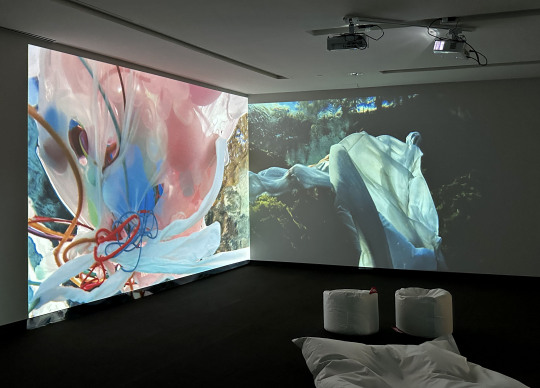
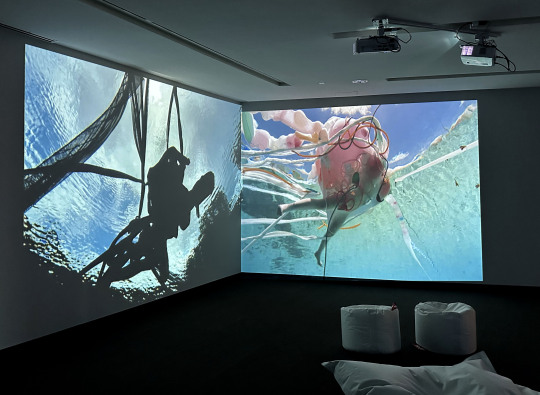
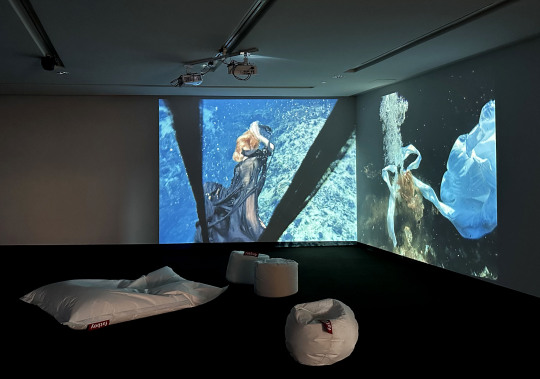
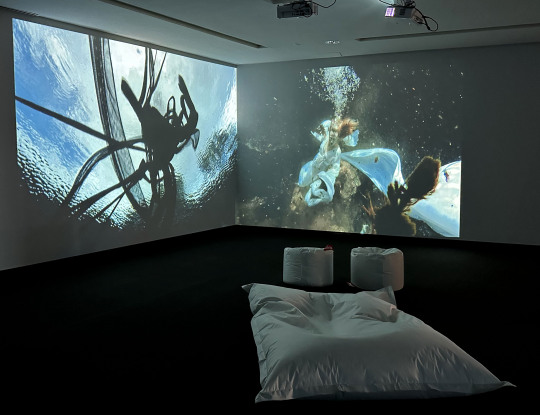
This exhibition closes on 4/14/24.
#Brookhart Jonquil#Art#Janaina Tschäpe#Museum of Fine Arts St. Petersburg#The Nature of Art#Art Installation#Art Shows#Earth#Environmental Art#Film#Florida Art Shows#Installation Art#Mermaid#Mixed Media Art#Myth#Painting#Sculpture#Sea Maiden#St. Pete Art Shows#Underwater Photography#Underwater Video#Video#Voltaire
1 note
·
View note